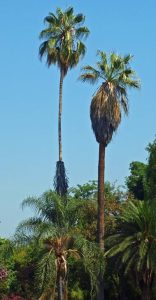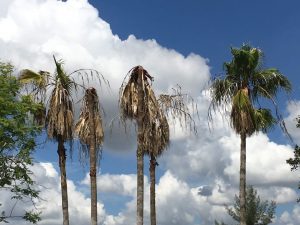 Growing up to 90 ft. tall, the Washington Palm (Washingtonia robusta) is one of the tallest in the palm family. At this height, it can be visually over-powering in landscapes with single-story buildings, but makes a great addition to landscapes with taller buildings.
Growing up to 90 ft. tall, the Washington Palm (Washingtonia robusta) is one of the tallest in the palm family. At this height, it can be visually over-powering in landscapes with single-story buildings, but makes a great addition to landscapes with taller buildings.Planting Site
Washingtonias do best in full sun and prefer well-drained soils. In addition to growing 60 to 90 ft. tall at maturity, Washingtonias can also be 10 to 15 ft. wide, so particular attention should be given to selecting an appropriate planting site. Washingtonias have also been listed as a cautionary-invasive plant for South Florida planting zones. To learn more about invasive plant species assessments, click on this link.
Nutrient requirements
Potassium deficiency (yellowing fronds or yellow/brown spots on fronds) is usually the most common nutrient deficiency observed in Washingtonias. It is recommended that a soil pH reading is done prior to applying fertilizer, and that a fertilizer specially formulated for palms is used. Click on the link to learn more about palm nutrient requirements and fertilizing palms.
 Pests and diseases
Pests and diseases
Although in the landscape, pests are typically not a major problem for Washingtonias, the fungal disease Fusarium wilt is most commonly seen. Symptoms of Fusarium wilt include brown, drooping fronds. To learn more about Fusarium wilt on Washingtonias, click on this link.
Learn more:
For more information on the Washingtonia Palm, click on this link.
Source: UF/IFAS Pest Alert
Note: All images and contents are the property of UF/IFAS.



